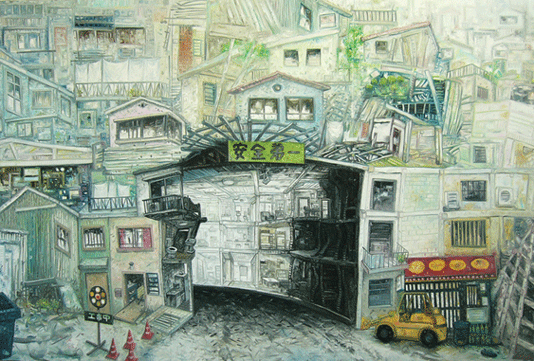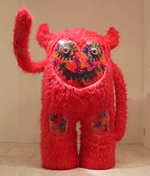Japanese Art, Anime on Display at Tufts Gallery
Sacred Monsters: Everyday Animism in Contemporary Japanese Art and Anime
September 10-November 22, 2009
Public opening reception: September 17, 2009, 5:30-8pm

Oscar Saito Oiwa, Tunnel, 2007. Oil on canvas, 227 x 333 cm. Courtesy of PPOW Gallery, New York, NY and the artist.
The following announcement is from the Tufts University Art Gallery:
The Tufts University Art Gallery presents Sacred Monsters: Everyday Animism in Contemporary Japanese Art and Anime, from September 10 to November 22, 2009. Co-curated by Gallery Director Amy Ingrid Schlegel and Jonathan Barracato, with advisors and Tufts professors Hosea Hirata, Charles Shiro Inouye, and Susan J. Napier, this exhibition includes twenty-one works by eight emerging and mid-career Japanese artists, as well as seven anime and one live action film screened continuously in the Gallery.
Monsters and spirits are prominent elements of Japanese culture, whose representations range from the truly grotesque to the “creepy cute.†Unlike in the Judeo-Christian tradition, this Other World (ikai) in Japanese Shinto belief is visibly and tangibly present, rather than physically removed and conceptually distant. The Shinto belief in animism—that all things are alive and imbued with sacred spirit – allows for a visual playfulness that has inspired incredible and sometimes incredulous artistic visions. Expression of this ancient, traditional belief is re-emerging in the contemporary period and taking flight in the wildly fanciful postmodern visions of more and more artists and anime directors, who commingle the ordinary and the extraordinary, the mundane and the divine.
Chiho Aoshima’s anime-inspired work evokes a gothic realm of spirits and monsters that are neither anthropomorphic things or animals nor distorted, grotesque humans. A visit to the ancient Buddhist temple in Nara, Japan, at night sparked painter Nobuhiro Ishihara’s interest in investigating the legend of the deer-messenger. He reimagines the folkloric spirit as a wise but tormented kami (god).
Kenjiro Kitade’s earthenware sculptures of “sheep-children,†with human bodies and mismatched gas-masked, horned heads, symbolize a premature, foreboding intelligence of environmental disaster. Mahomi Kunikata paints scenes grounded in Japan’s traditional culture of matsuri (Shinto festivals). Her manga-esque drawing style and big-eyed characters are pastiches of contemporary and traditional social references.
Tomokazu Matsuyama re-presents the mythical protector creature known in Japan as the kirin. Japanese art has depicted this powerful yet peaceful beast as having the attributes of a deer, a dragon, and a unicorn. Matsuyama creates a monumental anime-inspired doll head with a miniature dollhouse inside.
Oscar Oiwa’s paintings compose strangely unpopulated cityscapes that seem animated by mysterious, unseen forces. Tunnels and passageways beckon us to foreboding realms we can only imagine.
Finally, fashion design duo Tokyo Kamen created a troupe of five life-size “monster dolls” made of brightly colored fake fur and decorative materials.
On the web:
www.ase.tufts.edu/gallery